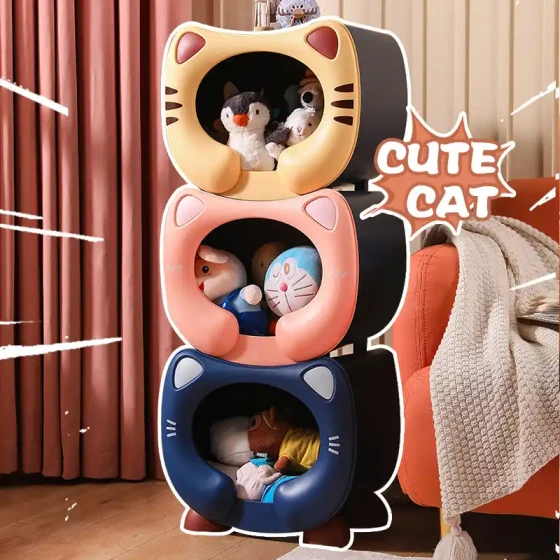Two Cats Suddenly Fight After Long-Term Cohabitation_Why Do Cohabiting Cats Suddenly Turn Against Each Other
The two cats at home were clearly sleeping sprawled out together in the same cat bed just a few days ago, so why do they suddenly dislike each other and even come to blows? This change in their “plastic brotherly” or “plastic sisterly” relationship leaves many cat owners confused, feeling both heartbroken and helpless. In fact, conflicts between cats don’t come from nowhere; even cats that have lived together for a long time can have their relationship change due to various reasons, breaking the previous harmony. Understanding these underlying triggers is the first step to helping the cats reconcile.
The reasons cats might suddenly attack a familiar companion can be complex and varied, including but not limited to: physical discomfort, stress caused by environmental changes, territorial and resource redistribution, or simply an accidental redirected attack or misunderstanding. As pet owners, we need to be like detectives, carefully observing the cats’ behavior to identify the root of the problem in order to address it properly.
Why Do Cohabiting Cats Suddenly Turn Against Each Other? A Deep Dive Into the Causes

Cats are sensitive animals with strong individual ideas. Their worldview and social interactions differ from humans. What appears as a sudden fight is often the result of long-term buildup or an instantaneous trigger. Here are some common reasons for sudden hostility between long-term cohabiting cats:
1. Physical Discomfort or Pain
Imagine if you were feeling unwell or had pain in some area; would your temper not be worse? Cats are the same. Underlying health issues, such as arthritis, toothache, urinary system diseases (for example, acute cystitis that may lead to inappropriate urination and thus conflicts), hyperthyroidism, or other pains, might make usually docile cats irritable or anxious, making conflicts more likely. If a cat suddenly becomes aggressive or shows abnormal attack behaviors, a comprehensive checkup at the vet should be done first to rule out medical causes.
2. Stress from Environmental Changes
Cats are creatures of habit and dislike change. Small “minor” things at home might be “earth-shattering” to them, enough to cause stress. For example:
- Changes in Family Members: The addition of a new member (newborn baby, new roommate) or the departure of familiar people (due to business trips or vacations) can disrupt the family balance and unsettle the cats.
- Home Environment Adjustments: Even moving furniture, adding new items, or strange smells or noises from renovations can stress cats, making them feel “my territory is invaded” or “what is this thing?”.
- Changes in Routine: Altered owner work hours, reduced companionship time, etc., can affect cats’ sense of security and accumulate stress.
- External Stimuli: A sudden appearance of a strange cat outside the window, noises like fireworks or renovation sounds, may also make indoor cats nervous.
When stressed, cats may use aggression to vent or cope. Prolonged stress may increase anxiety and aggressiveness.
3. Territorial and Resource Competition
Although house cats don’t have to fight for survival like wild cats, they still possess strong territorial instincts. In a multi-cat household, apparent peaceful coexistence can conceal underlying tensions. To cats, important resources include:
- Core Territory: Cat beds, favorite sleeping spots, high places (like cat trees) — these are places where they assert ownership.
- Food and Water: The number and location of food and water bowls may prompt contests.
- Litter Boxes: Insufficient quantity, poor placement, or lack of cleanliness can cause conflicts over litter boxes, even inappropriate urination to mark territory.
- Owner’s Affection: Competing for the owner’s attention and “favor” is also common, known as “favoritism fights.”
When cats feel their resources are threatened or unfairly distributed, they may resolve it through fighting to reaffirm their status. Although cats do not have a strict linear hierarchy, conflicts over resources still occur.
4. Redirected Aggression (What Is “Innocent Bystander” Aggression?)
This is a common reason for fights that confuses many owners. Simply put, a cat feels anger or anxiety due to something (like seeing another cat outside the window, hearing loud noises, or frustration) but cannot directly attack the cause of the emotional disturbance, so it “redirects” this anger toward a nearby innocent “companion.” For example, a cat sitting by the window sees a stray cat downstairs and thinks, “Who dares invade my territory!” but cannot get out. Another cat happens to walk by and becomes the “innocent bystander,” getting attacked out of misplaced frustration. This aggression is a stress reaction occurring at the height of emotional arousal, often a reflex without conscious thought.
5. Poor Social Skills or Misunderstood Signals
Some cats had limited interaction with other cats during kittenhood or have experienced estrangement on the streets, resulting in poor social skills and lack of trust in other cats. This may cause an inability to correctly interpret signals from other cats. Sometimes interaction such as chasing or wrestling is just play, but if one cat misreads the other’s intentions or the boundaries of play are not clear, it can escalate into real conflict. If play includes signs like puffed fur, hissing, low growling, or extended claws, it probably isn’t simple play.
6. Hormonal Influences (Especially Unneutered Cats)
Unneutered cats, especially males, may be more prone to conflicts due to sexual hormones, competing for mates or territory. Timely neutering helps reduce such aggressive behaviors.
How to Tell if Cats Are Playing or Fighting?
Distinguishing between play and real fighting is very important. Play usually involves reciprocal chasing, controlled wrestling strength, relaxed body language (though sometimes rough but not truly aggressive), and alternating chasing and being chased.
Signs of real fighting include:
- Tense Body Language: Puffing fur, arched backs, ears pinned back in “airplane ear,” dilated pupils, vigorously flicking tails.
- Aggressive Sounds: Hissing, low growling, howling or screaming.
- Intense Attacks: Claws out, pouncing and biting (possibly neck locking or forceful kicking), rough and sustained actions with one cat usually initiating the attack.
- No Calming After Fight: Even after brief separation, cats try to continue attacking or the defeated cat shows signs of fear and avoidance.
Solutions to Cohabiting Cats Fighting Problems
Once confirmed that cats are truly fighting, timely intervention is needed, but do not attempt to pull them apart with bare hands to avoid injury.
Immediately Stop the Conflict:
- Create Noise: Clap loudly, stomp feet, make sharp sounds, or use a spray bottle (some cats are sensitive to water) to distract them and temporarily stop the fight.
- Block Their Vision: Use cardboard, cushions, or towels to shield their sight, physically preventing further confrontation.
- Safe Separation: Take the opportunity to separate the cats temporarily into different rooms to allow cooling down.
Long-Term Improvement Strategies:
- Veterinary Examination: Prioritize vet visits to exclude underlying health issues.
- Reintroduction Process: If the conflict is severe, follow a new-cat introduction routine to help cats readapt to each other, including:
- Complete Separation: Keep cats completely apart with their own food, water, litter boxes, and resting areas.
- Scent Exchange: Swap each other’s mats, towels, or toys so they get familiar with the other’s scent. Wiping one cat with a clean cloth then using it on the other helps establish “group scent.”
- Visual Contact: Set up barriers like gates or screens at doorways for safe visual access without direct contact.
- Supervised Interaction: Once improved, allow brief, supervised interactions during positive activities (feeding, playing), gradually extending interaction times.
- Increase Resources: Ensure ample and dispersed critical resources at home. Follow the “number of cats N+1” rule for litter boxes and provide multiple food bowls, water bowls, and comfortable resting spots.
- Enrich Environment: Add vertical space (cat trees, shelves), hiding spots (boxes, cat beds), giving cats more room for movement and retreat to reduce stress and conflicts. Provide various toys to satisfy hunting instincts and expend excess energy.
- Consistent Routine: Maintain stable feeding, play, and rest schedules to build a sense of security.
- Fair Treatment: Avoid favoritism but don't overly emphasize fairness in front of cats; take a natural approach. Reward friendly behaviors.
- Understanding and Patience: Changing cat behavior takes time and patience. Some cats are naturally less suited to group living or need longer to adapt. Avoid corporal punishment as it only increases their stress and negative emotions.
- Seek Professional Help: If aggression is severe or persistent, consider consulting a professional animal behaviorist or vet for personalized solutions.
Frequently Asked Questions
- Q: Do cats suddenly fight because of jealousy?
A: Jealousy (competing for owner’s attention) can be one reason, but usually it’s a combination of factors like resource competition and lack of security. - Q: Is it true cats fight to compete for the "alpha" position?
A: Cat society does not have a strict hierarchy. Their conflicts are mostly about protecting resources, territory, or reacting to threats, not competing for a fixed “leader” status. - Q: Can cats get injured from fighting?
A: Real fights can cause scratches, bites, even serious internal injuries or infections. Timely intervention and checking cats for injuries is very important. - Q: Should I scold cats loudly when they fight?
A: Loud scolding or punishment can increase their stress and doesn’t truly solve the problem; it might make things worse. Other distraction methods or physical separation are recommended.
Summary
Raising cats is a joyful experience, and having a multi-cat household doubles that joy (and challenge!). When cats that have coexisted peacefully for a long time suddenly start fighting, it’s upsetting. But this problem is not unsolvable. Through careful observation, identifying causes, and using scientific and effective methods, most multi-cat families can regain peace and happiness. Remember that patience, understanding, and love are the best remedies to help cats resolve conflicts and reconcile.



